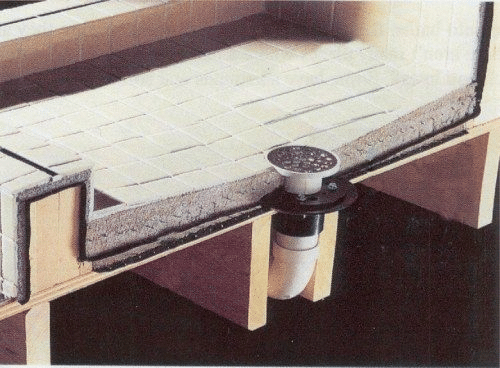
First, you need to pinpoint exactly where and when you are having a leak in shower pan. Make a note of the location of the leak. Is it from the ceiling? Maybe a wall? Can you tell by seeing which area of the shower is leaking?
Specifically, is the tiled shower floor leaking (leak in the shower pan), or could it be the wall that houses the shower controls? You can determine if you are searching for a plumbing leak or a tile failure by determining which area of the shower is dripping.
Does the shower always leak, or just when it’s running? Does it take a long or short time to observe signs of water leaking? All of these factors can help you identify the issue by providing clues.
You can also conduct some tests by carefully manipulating the direction of the water flow. How can you determine where the leak in your shower is coming from?

If the shower drain is clogged with too much debris, water may pool and leak into the shower’s floor from the space between the drain and the shower base. Also, water will leak into the floor through a drainage system that was built shoddily and carelessly.
The degree of structural element displacement caused by a load is known as deflection. The amount that the weight of a shower occupant affects the structure of your shower base is known as deflection.
The shower base ideally shouldn’t shift or become dislodged while being used. With such movement, the shower base can easily have leaking water into the floor below and around it.
These are factors that are simple to spot if you pay close attention. If you clean the shower pan regularly enough, you should be able to spot leaks and other problems.
After eight hours, go back to check on the water level in the shower base. If it has dropped below the level you designated, a shower base leak is probably present.
At this stage, you should also look to see whether there is any obvious water damage or stains on the floor beneath the bathroom.
The first action is typically to hire a professional plumber because a professional plumbing repair is a best-case scenario repair.
To address any plumbing problems, including those involving the drain line or supply lines feeding the shower, they can cut a hole in the wall or ceiling above or beneath the shower.
If that was the problem, after the plumber has made the repair, you’ll need someone to fix the drywall, then prime, texture, and paint it. The rest is quite simple, though.
If it seems that your plumbing is not the problem, move on to the next phase. Make an appointment with your tile contractor to have the shower pan and tile inspected if you see any issues with the walls surrounding your shower or the curb, or if your plumber thinks the plumbing is fine.
To further identify the cause of your shower’s leak, they might take off a couple of tiles, crack open the surrounding walls, and utilize a moisture meter.
The bad news is that there is no such thing as “leaking tiles.” Any leak beyond the tile is a sign that the system is broken. The purpose of the tiles is purely decorative and to offer a durable surface; the materials underneath are what make the shower watertight.
Let’s start by stating that adding sealer, re-caulking, or regrouting is not a permanent solution for a shower leak. There are businesses that promote these services to remedy shower leaks, but they should only be viewed as aesthetic upgrades.
At most, they might provide a short-term fix. If you use this technique to buy some time, be aware that the failure will eventually happen again.
Complete removal of the damaged region, followed by a rebuild, is required for a shower repair to be permanently effective. This entails, at the very least, rebuilding the shower’s base, which includes the pan.
By doing this, the leak will be fixed without having to spend money on remodeling the entire shower. Flood testing of the pan is a good idea after the waterproofing has been repaired.
A replacement pan liner that fits the shower can be available for about $50 and $100 at a big box retailer. These pre-built pans won’t fit as snugly as a permanent shower pan replacement, but they might be sufficient to get you by for a while.
The best course of action is to find a shower repair expert in your neighborhood, because leaking shower pans can the ability to severely damage various sections of your home with water. A contractor may even need to tear up the surrounding floor or perhaps the foundation to replace the entire shower base, which is a more difficult task.
Although grout and most tiles don’t have a waterproof coating, caulk may assist in preventing water from entering the corners of the tiles. Eventually, the water will pass through the assembly and down into the ground.
Definitely a smart move. It’s a fantastic approach to make sure there is no shower pan leak motion before beginning the difficult work of installing the tile flooring.
A solid shower floor that channels water down the drain is called a shower base. But there are a number of reasons why you could have leaking shower pans. Shower pan leaks are frequently caused by motion, deterioration, a poor drainage system, and displacement.
Since they jeopardize a home’s foundation, shower pan leaks demand prompt maintenance and care. A leaky shower floor can be fixed by replacing the pan liner, using epoxy, replacing the shower grout, or even installing a prefabricated shower pan.
I bring over 9 years of dedicated plumbing experience to the table. As a seasoned professional in the plumbing industry, I've tackled a wide range of projects, from residential repairs to large-scale commercial installations.
